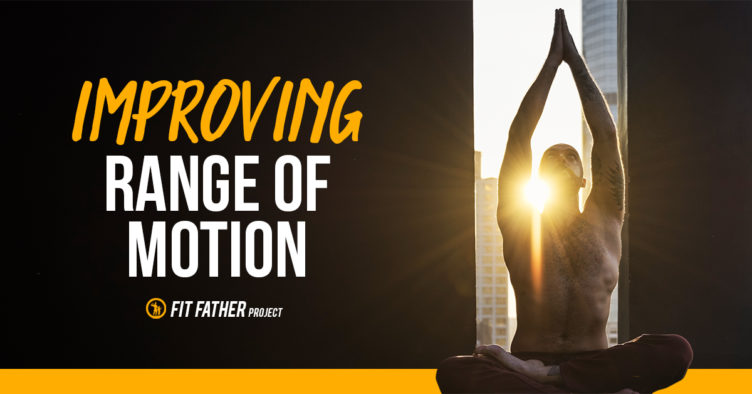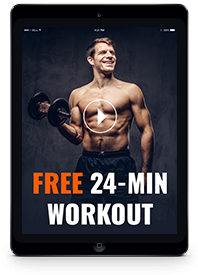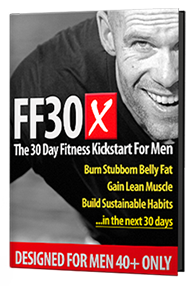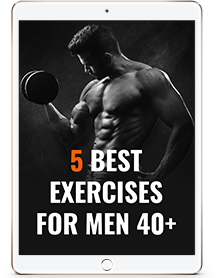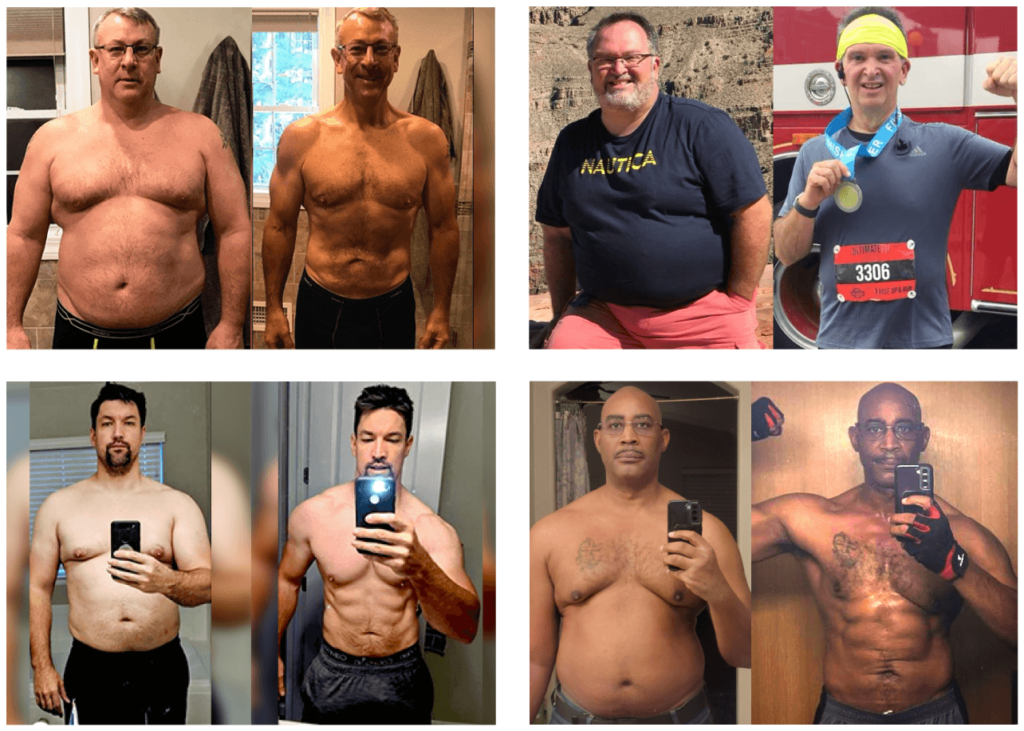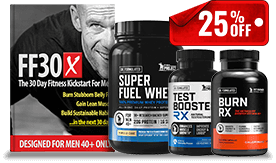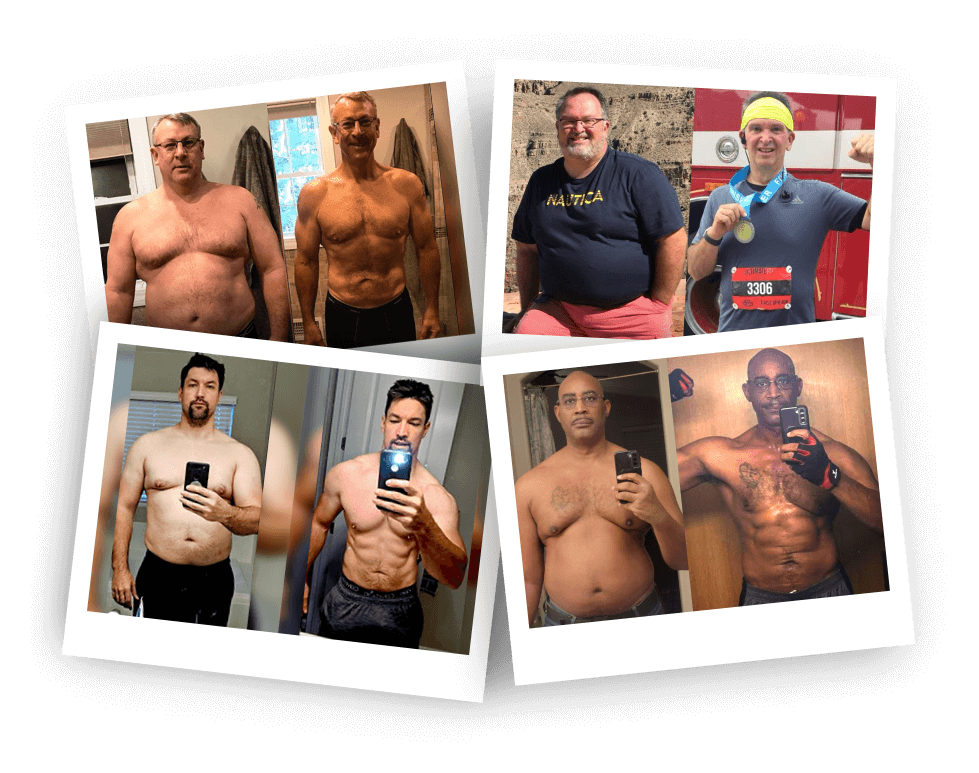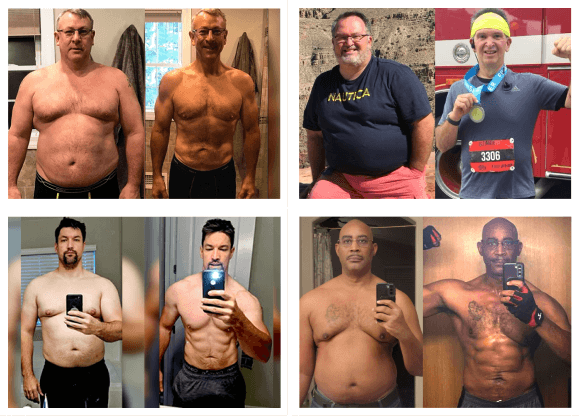Is your range of motion not what it used to be? Are you not quite as flexible or mobile anymore?
Tired of stiff, sore joints or poor flexibility increasing your risk of injuries and diminishing your mobility?
Knowing how to improve your range of motion after 40 is crucial.
Take care of your body to optimize strength and mobility over time, and look and feel healthy for life.
Learn more about how to optimize range of motion and boost flexibility after 40 by following a few simple tips and tricks!
Why Range of Motion is Important
Range of motion, or flexibility, is important at any age but especially after 40.
With increasing age often comes stiffer joints, less joint lubrication, thinner cartilage, and shortened ligaments.
If you're not flexible, your risk of injures and limited mobility increases the older you are, especially if you have risk factors for inflammation.
Taking care of your body and making simple lifestyle changes is the key to an optimal range of motion and overall health and wellness.
Looking for a morning pick-me-up AND a way to improve your flexibility and fitness? Check out these morning stretch routines!
Here’s A Free 24-Min Fat Burn Workout For Busy Men 40+
This powerful workout will reignite your metabolism to burn fat 24/7 like you did in your 20s…
16 Ways to Boost Range of Motion After 40
Consider some of the following healthy lifestyle strategies to boost your range of motion naturally and maximize mobility at every age — especially after 40!
1. Warm-Up Before Exercise
Make sure to properly warm up your muscles and joints before working out, so you don't injure soft tissues during exercise.
Warm-up by doing light walking, jogging, biking, jumping jacks, or other forms of light cardiovascular exercise to boost joint flexibility and range of motion prior to exercise.
Aim to complete a 5-minute warm-up each time you work out, especially prior to high-intensity training.
2. Try Dynamic Stretching Pre-Exercise
Consider doing dynamic stretches prior to exercise.
Dynamic stretches are moving stretches similar to actual movements you plan to do during each workout, but at a lower intensity.
In other words, during dynamic stretching your body and limbs are moving, rather than staying still and holding a stretch (as with static stretching).
Learn how to properly warm-up before a workout in this video.
3. Complete Static Stretching after Workouts
After you complete your workout and you cool down for about 5 minutes, while your muscles and joints are still nice and warm, is the perfect time to focus on static stretching to increase your range of motion and mobility.
Stretch your legs, arms, back, neck, glute muscles, chest, shoulders, chest, ankles, and even your abdominal muscles.
Stretch the muscles you've exercised that day, or complete full-body stretches before your muscles cool down entirely.
The American College of Sports Medicine (ACSM) recommends you stretch each muscle group for at least 60 seconds, at least two or three times (or more) each week.
You can stretch a muscle group for 60 seconds at a time, or break up each stretch among 20- or 30-second time intervals to equal at least 60 seconds.
Use this ground-up, post-workout stretch routine to get rid of lactic acid from your muscles after your workouts and help to avoid delayed onset of muscle soreness (DOMS).
4. Drink Plenty of Water
Drinking enough water before, during, and after exercise helps your body function the way it's designed to and lowers your risk of getting injured. Drinking a lot of water can enhance your range of motion, in addition to reducing your risk of fatigue and dehydration.
Everybody is different, but men often need at least 16 cups of fluids daily to achieve or maintain optimal health. Drink plenty of water before workouts, during exercise, and after being physically active (all throughout the day) to keep energy levels high, maximize athletic performance, and help your body achieve optimal strength and range of motion.
5. Push Yourself, but Not Too Much
Stretches that increase range of motion shouldn't feel painful, but you should still push yourself to the limit to allow the pull of a stretch to do its job properly.
Your muscles should feel some pressure during each movement.
Avoid stretching muscles and joints to the point of being painful, so you can reduce the risk of tearing or damaging soft tissues.
Never stretch cold muscles.
6. Get a Deep Tissue Massage
Receiving a deep tissue massage is an excellent way to stretch, strengthen, and relieve tight muscle and joint tissues.
To increase range of motion and mobility, reduce chronic pain, lower your risk of getting injured, and accelerate healing after tissue damage, consider getting routine massages from a professional or even a family member.
Book deep tissue massage sessions with a therapist, ask a family member to massage tight tissues, or get a massage chair or device to keep at home to maintain optimal health, reduce stress or anxiety, and save time and money.
Got joint pain? Here are proper preventative steps you can take to alleviate and fix it today.
7. Try Yoga, Tai Chi, or Pilates
Yoga, tai chi, and Pilates are examples of stress-relieving exercises that help you burn calories, boost strength and flexibility, and optimize range of motion and mobility over 40 in men and women.
Try fat-burning yoga poses to help you feel better, lose weight (if that's your goal), and lower your risk of injury with age.
While you might not burn quite as many calories completing flexibility workouts compared with other types of exercise, you'll feel great afterward and can improve overall health and wellness.
Does yoga really work for weight loss? Find out in this in-depth blog!
Here’s How Busy Guys 40+ Are Finally Losing Weight…
If you’re in your 40s, 50s, & 60s, you need to eat and exercise differently to lose weight & actually keep it off…
8. Consider Foam Rolling
If you've never tried foam rolling to increase range of motion after age 40, now's the time to give it a try!
Studies show that Myofascial release using a foam roller helps improve joint range of motion, flexibility, athletic performance, muscle pain, and muscle recovery post-workout.
It can also relieve stress and anxiety, improving your overall mental health.
Researchers found that rolling before you exercise appears to be the most beneficial way to use foam rollers to improve athletic performance.
However, you can foam roll any time of day to reap range-of-motion benefits, even when you're not working out.
In addition to enhancing flexibility, foam rollers can relieve soreness, alleviate stiffness and muscle tension, reduce inflammation, and enhance mobility.
Get the most out of your foam roller with this “Roll 4, Range 4” warm-up routine.
9. Take Dietary Supplements for Joint Health
Taking dietary supplements can improve your joint health, reduce inflammation and pain, enhance your range of motion and mobility, and lower your risk of getting injured.
While it's important to check in with your doctor before trying any new dietary supplements, especially if you're taking medications, consider the following supplements for joint health in men:
- Glucosamine
- Chondroitin
- Methylsulfonylmethane (MSM)
- Turmeric
- Tamarind seed
- Boswellia
- S-adenosyl-L-methionine (SAMe)
- Fish oil supplements
- Multivitamin supplements
Getting the essential nutrients your body needs daily is the best way to optimize muscle and joint function, reduce inflammation, and boost flexibility at any age – especially for men over 40!
10. Seek Treatment for Arthritis
About 30 percent of men in the United States have arthritis, with numbers increasing to almost 60% in men age 65 and older.
If you have sore or stiff joints associated with arthritis, adopting healthy lifestyle habits can lower your risk of inflammation to optimize joint range of motion and function.
In some instances, however, taking arthritis medications is the best way to keep inflammation levels as low as possible and reduce your risk of arthritis-related joint damage over time.
If you suffer from joint stiffness, swelling, pain, or bone or joint deformities, ask your doctor to test you for arthritis and develop a personalized treatment plan to optimize joint and overall health.
11. Eat Nutritious Foods
Eat nutritious foods to help maintain a healthy weight and diminish inflammation that can restrict joint range of motion.
To clean up your diet, eliminate highly processed foods like white bread, white rice, baked goods, sugary drinks, processed meats, and many microwavable dinners.
Steer clear of fried foods, sweets, and other foods containing added sugars.
Even drinking diet sodas flavored with artificial sweeteners isn't the best healthy eating strategy and can contribute to unplanned weight gain.
Replace unhealthy foods with fruits, vegetables, legumes, nuts, seeds, whole grains, protein foods, and heart-healthy fats.
Try the following to optimize muscle and joint health over time:
- Fill half of your plate with leafy greens, broccoli, cauliflower, cucumbers, bell peppers, tomatoes, onions, asparagus, zucchini, or other non-starchy vegetables.
- Fill one-fourth of your plate with chicken, turkey, fish, seafood, organic grass-fed lean beef, eggs, or plant-based proteins.
- Fill one-fourth of your plate with dried beans, peas, corn, sweet potatoes, quinoa, brown rice, oatmeal, or other whole grains.
- Eat avocados, nuts, seeds, olives, olive oil, hummus, additional plant-based oils, nut butter, or other heart-healthy fats at each meal.
- Pick Greek yogurt, low-fat milk or plant milk, low-fat cottage cheese, plain kefir, or other calcium-rich foods about 3 times daily.
- Consider protein shakes as meal replacements for weight loss, or as post-workout fuel to build or maintain lean muscle mass.
Space out meals so you can eat smaller meals or snacks every few hours, rather than consuming one or two very large meals.
Need help choosing nutritious foods? This video will show you how to properly read nutrition labels and what nutrition facts REALLY mean.
12. Get Plenty of Rest
Rest is crucial to ensure your body heals properly after stretching and workouts.
Take a day or two off from vigorous exercise, but keep your body moving around every day.
Make sure you're getting plenty of sleep each night (at least 7 hours routinely) to stay as healthy as possible, enhance tissue regeneration, and reduce inflammation and joint stiffness.
To ensure you're getting a good night's sleep, avoid going to bed very full or too hungry.
Sleep in a dark, cool room.
Reduce stress as much as you can and ask your doctor about possible treatments if you suffer from sleep apnea.
Quality sleep is crucial for optimal muscle and joint health.
13. Exercise Regularly
Exercise daily, or almost every day, to keep your muscles and joints limber.
Make sure to warm up for at least 5 minutes prior to workouts and stretch afterward.
Aim to complete at least 30 minutes of scheduled exercise most days of the week by combining resistance training with cardiovascular workouts.
Doing so can optimize strength and flexibility.
Want to gain muscle, burn fat, and achieve the physique you desire without stepping foot in a gym? Get this FREE workout now!
What Are The 5 Best Muscle Building Exercises For Men 40+?
The secret to building age-defying muscle in your in 40s, 50s, & 60s is to modify the best muscle building exercises (bench, squats, rows) to make them safe on your joints…
14. Avoid Sitting for Long Time Periods
Sitting down too much throughout the day can lead to stiffness and limited range of motion.
Being sedentary most of the day can also add unwanted pounds and drain your energy levels over time.
To avoid sitting down the majority of the day, take a 5-minute walk or stair-climbing breaks every hour at work, consider using a standing computer desk, and be mindful about how many hours you're sitting down each day.
Aim to complete at least 45 minutes of daily activity in addition to planned exercise.
Doing so keeps your body moving, boosts your metabolism, reduces stiffness, and optimizes range of motion after 40.
For example, consider playing outdoor games with your kids, walking your dog, doing yard work, or cleaning windows.
Chained to your desk all day? Learn about the dangers of sitting for too long and how to combat the negative effects of sitting.
15. See Your Doctor
After reviewing your medical history and symptoms, examining your joints, and completing diagnostic imaging tests when necessary, your doctor might recommend medical treatment to reduce joint inflammation and increase range of motion.
For example, they may suggest taking medications, receiving injections, trying physical therapy, opting for regenerative medicine (stem cell treatment), or even undergoing surgical procedures in the case of a severe injury.
16. Maintain a Healthy Weight
Maintaining a healthy weight is one of the best ways to keep inflammation in your body as low as possible and optimize range of motion in men over 40.
If you struggle to get excess weight off on your own, you can turn to Fit Father Project health experts for support and guidance.
They offer a weight loss program with proven success, designed just for men!
It's helped hundreds of thousands of men drop weight and body fat, and maintain lean physiques for life.
When you join the Fit Father Project 30X (FF30X) weight loss plan, you receive custom meal planning, fat-burning and muscle-building workouts, health coaching, motivational support, recipes, weekly newsletters, and much more!
What is a good rate of weight loss? This video provides you with some weekly weight loss expectations to guide you on your weight loss journey.
Which Next Steps Should I Take?
Take baby steps when trying to increase range of motion, flexibility, and mobility after 40.
Make small changes, one at a time, to slowly improve the way your body feels and functions.
Complete flexibility exercises on a routine basis, or nearly every day if possible.
Begin by increasing exercise, static and dynamic stretches, foam rolls, massages, or other simple lifestyle changes to get on the road toward optimal range of motion, mobility, and overall wellness.
Gradually increase daily doses of exercise and simple activities of daily living, be sure to warm up and cool down with workouts, make simple dietary changes, and take dietary supplements as needed to reduce inflammation, stiffness, soreness, and chronic pain.
Sign up for the Fit Father Project's free one-day meal plan and workout to optimize range of motion and get started on the journey toward a healthier, happier, more fulfilling life today!
Writer, The Fit Father Project Erin Coleman is a registered and licensed dietitian with over 15 years of freelance writing experience. She graduated with her Bachelor of Science degree in nutritional science from the University of Wisconsin-Madison, and completed her dietetic internship at Viterbo University in La Crosse, Wisconsin. Prior to beginning her career in medical content writing, Erin worked as Health Educator for the University of Wisconsin-Madison Department of Internal Medicine. Her published work appears on hundreds of health and fitness websites, and she’s currently working on publishing her first book! Erin is a wife, and a Mom to two beautiful children.Erin Coleman, B.S. - Nutritional Science, R.D., L.D.
This proven "Fit Father Program" has helped 38,000 busy men 40+ lose weight, rebuild muscle, and finally keep the weight off. If you're frustrated with stubborn belly fat, failed diets, and time-consuming workouts, this is the answer you’ve been looking for…Here’s How Busy Fathers Over 40 Are Finally Burning Stubborn Belly Fat & Getting Healthy Without Restrictive Diets or Time-Consuming Workouts
GET STARTED TODAY FOR FREE
*Please know that weight loss results & health changes/improvements vary from individual to individual; you may not achieve similar results. Always consult with your doctor before making health decisions. This is not medical advice – simply very well-researched info on improving range of motion.

